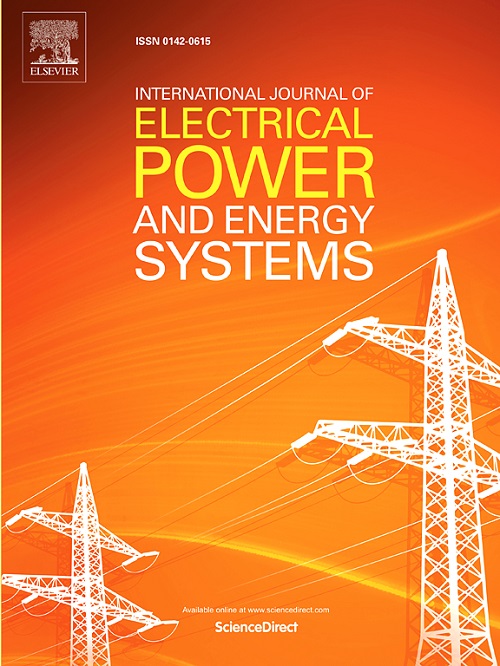Optimal control strategy on hybrid energy storage systems to improve system inertia for a bipolar DC microgrid
IF 5
2区 工程技术
Q1 ENGINEERING, ELECTRICAL & ELECTRONIC
International Journal of Electrical Power & Energy Systems
Pub Date : 2025-03-25
DOI:10.1016/j.ijepes.2025.110628
引用次数: 0
Abstract
For an islanded bipolar DC microgrid with positive and negative hybrid energy storage systems (HESSs), researchers need to take into account a special problem related to improving the system inertia by the HESSs. To solve this issue, an optimization control strategy for multiple HESSs is proposed. The strategy includes a battery and a supercapacitor (SC) for each HESS, with inertia improvement for the SCs. Specifically, to effectively improve the system inertia, a dynamic power distribution strategy is proposed for solving the unreasonable power distribution problem on positive and negative SCs caused by the asymmetric load power on the positive and negative systems. Subsequently, to improve the system inertia at the right time, 2 operating-state discriminators, one working as an output discriminator and the other as a recovery discriminator, are introduced for each SC. These discriminators are employed for avoiding the influence of SCs on the state-of-charge balancing on the positive and negative batteries and to control the output and recovery actions of the SCs. Based on the 2 operating-state discriminators, 2 virtual DC generators (VDCGs) are introduced into the output paths of the SCs for improving the positive and negative system inertia when the output signals of the operating-state discriminators are activated. Furthermore, to improve the entire system inertia in a bipolar DC microgrid and solve the paradox between the inertia improvement and the lag in the dynamic response speed, a particle swarm algorithm is adopted to joint optimize the parameters of the 2 VDCGs. Finally, to make the SCs output power and improve system inertia repeatedly, 2 time-varying virtual inductors are introduced into the recovery paths of the SCs for accelerating the recovery speed of terminal voltages for SCs when the recovery signals of the operating-state discriminators are activated. The simulation results in different working conditions reveal that the proposed control strategy helps in obtaining reasonable output powers of the positive and negative HESSs, improving the system inertia, ensuring the reliable operation of the SCs, and achieving the optimal operation of the system. Therefore, the accuracy and effectiveness of the proposed control strategy were verified.
改善双极直流微电网系统惯性的混合储能系统最优控制策略
对于具有正负极混合储能系统(hess)的孤岛双极直流微电网,研究人员需要考虑利用hess改善系统惯性的特殊问题。针对这一问题,提出了一种多hess的优化控制策略。该策略包括为每个HESS提供一个电池和一个超级电容器(SC),并对SC进行惯性改进。具体而言,为了有效改善系统惯性,提出了一种动态配电策略,以解决由于正、负系统负载功率不对称而导致的正、负系统功率分配不合理的问题。随后,为了适时改善系统惯性,在每个SC上分别引入2个工作状态鉴别器,一个作为输出鉴别器,一个作为恢复鉴别器,以避免SC对正负极电池荷态平衡的影响,并控制SC的输出和恢复动作。在两个工作状态鉴别器的基础上,在sc的输出路径中引入两个虚拟直流发电机(vdcg),以改善工作状态鉴别器输出信号被激活时系统的正、负惯性。此外,为了改善双极直流微电网的整个系统惯性,解决惯性改善与动态响应速度滞后之间的矛盾,采用粒子群算法对2个vdcg的参数进行联合优化。最后,为了使SCs输出功率,反复提高系统惯量,在SCs的恢复路径中引入2个时变虚电感,当工作状态鉴别器的恢复信号被激活时,加快SCs终端电压的恢复速度。在不同工况下的仿真结果表明,所提出的控制策略有助于获得正、负hess的合理输出功率,改善系统惯性,保证SCs的可靠运行,实现系统的最优运行。验证了所提控制策略的准确性和有效性。
本文章由计算机程序翻译,如有差异,请以英文原文为准。
求助全文
约1分钟内获得全文
求助全文
来源期刊
CiteScore
12.10
自引率
17.30%
发文量
1022
审稿时长
51 days
期刊介绍:
The journal covers theoretical developments in electrical power and energy systems and their applications. The coverage embraces: generation and network planning; reliability; long and short term operation; expert systems; neural networks; object oriented systems; system control centres; database and information systems; stock and parameter estimation; system security and adequacy; network theory, modelling and computation; small and large system dynamics; dynamic model identification; on-line control including load and switching control; protection; distribution systems; energy economics; impact of non-conventional systems; and man-machine interfaces.
As well as original research papers, the journal publishes short contributions, book reviews and conference reports. All papers are peer-reviewed by at least two referees.

 求助内容:
求助内容: 应助结果提醒方式:
应助结果提醒方式:


